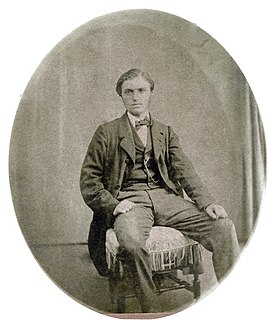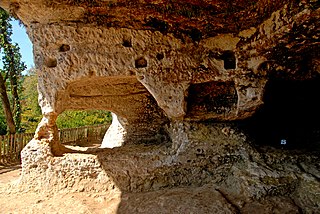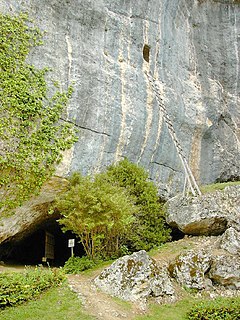
Cro-Magnon is an Aurignacian site, located in a rock shelter at Les Eyzies, a hamlet in the commune of Les Eyzies-de-Tayac-Sireuil, Dordogne, southwestern France. Abri de Cro-Magnon is part of the UNESCO World Heritage of the Prehistoric Sites and Decorated Caves of the Vézère Valley.

Louis Lartet was a French geologist and paleontologist. He discovered the original Cro-Magnon skeletons.

Édouard Lartet was a French geologist and paleontologist, and a pioneer of Paleolithic archaeology.

Les Eyzies-de-Tayac-Sireuil is a former commune in the Dordogne department in Nouvelle-Aquitaine in southwestern France. On 1 January 2019, it was merged into the new commune Les Eyzies.
1864 in archaeology. See also: other events of 1864.

Le Moustier is an archeological site consisting of two rock shelters in Peyzac-le-Moustier, a village in the Dordogne, France. It is known for a fossilized skull of the species Homo neanderthalensis that was discovered in 1908. The Mousterian tool culture is named after Le Moustier, which was first excavated from 1863 by the Englishman Henry Christy and the Frenchman Édouard Lartet.

Sansan is a commune in the Gers department in southwestern France.
Cailloux, Cailleux, or Caillaux is a French surname. Notable people with the surname include:
Events from the year 1881 in France.
Events from the year 1868 in France.

Montaigle Castle is a ruined medieval castle in Falaën in the municipality of Onhaye, province of Namur, Wallonia.

The archaeological site Abri de la Madeleine is a rock shelter under an overhanging cliff situated near Tursac, in the Dordogne département of the Aquitaine Région of South-Western France. It represents the type site of the Magdalenian culture of the Upper Paleolithic. The Bison Licking Insect Bite, a 20,000 year old carving of exceptional artistic quality, was excavated at the site. The shelter was also occupied during the Middle Ages. The medieval castle of Petit Marsac stands on the top of the cliff just above the shelter. An engraved bone rod from the cave, depicting a lioness licking the opening of either a gigantic human penis or a vulva, shows the first documented act of bestiality.

Henry Bernard Alfred Testot-Ferry also known as Henry de Ferry was a French geologist, archeologist and paleontologist. He was discoverer of the prehistoric site at the Rock of Solutré.

Laugerie-Basse is an important Upper Paleolithic archaeological site within the territory of the French commune Les Eyzies-de-Tayac-Sireuil in Dordogne. It is known for several works of art from the Magdalenian.
Reuss is a surname. Notable people with the surname include:
Termier is a surname. Notable people with the surname include:

Édouard Louis Stanislas Piette was a French archaeologist and prehistorian.

The Cave of Aurignac is an archaeological site in the commune of Aurignac, Haute-Garonne department in southwestern France. Sediment excavation and artefact documentation since 1860 confirm the idea of the arrival and permanent presence of European early modern humans during the Upper Palaeolithic. The eponymous location represents the type site of the Aurignacian, the earliest known culture attributed to modern humans in western Eurasia. Assemblages of Aurignacian tool making tradition can be found in the cultural sediments of numerous sites from around 45,000 years BP to around 26,000 years BP. In recognition of its significance for various scientific fields and the 19th century pioneering work of Édouard Lartet the Cave of Aurignac was officially declared a national Historic Monument of France by order of May 26, 1921.
This page is based on this
Wikipedia article Text is available under the
CC BY-SA 4.0 license; additional terms may apply.
Images, videos and audio are available under their respective licenses.











